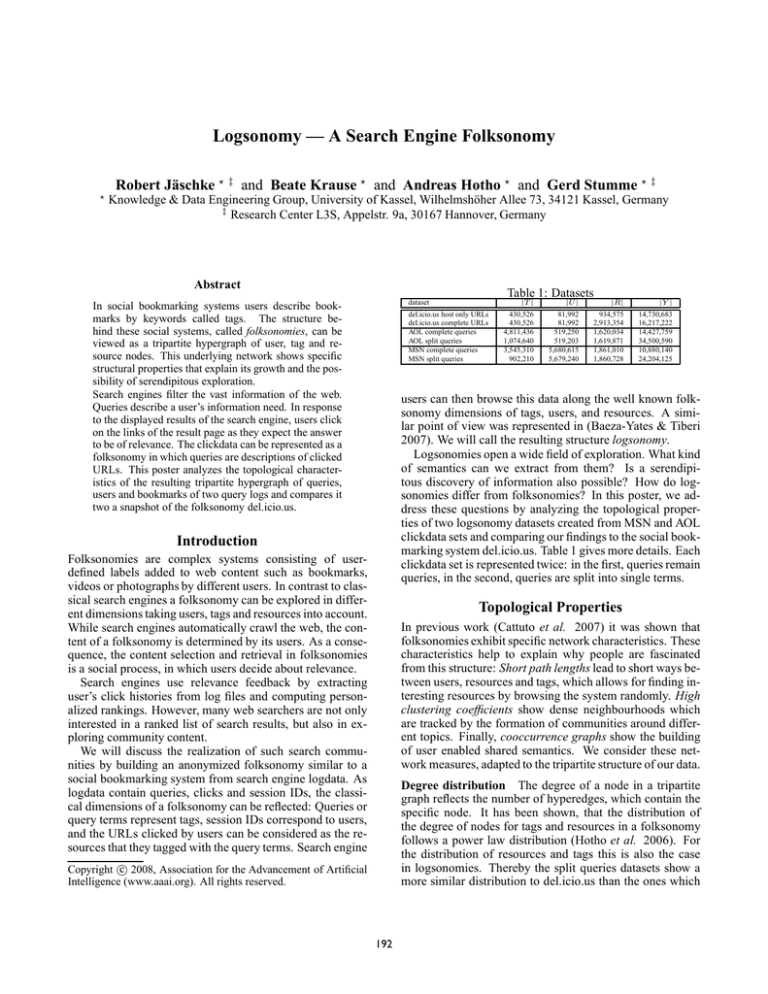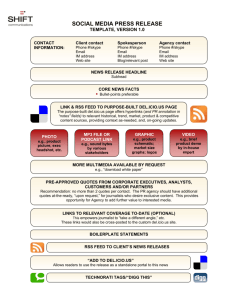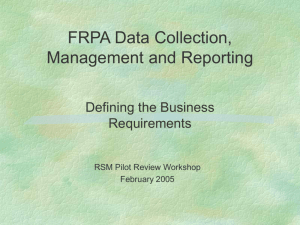
Logsonomy — A Search Engine Folksonomy
Robert Jäschke ⋆ ‡ and Beate Krause ⋆ and Andreas Hotho ⋆ and Gerd Stumme ⋆ ‡
⋆
Knowledge & Data Engineering Group, University of Kassel, Wilhelmshöher Allee 73, 34121 Kassel, Germany
‡
Research Center L3S, Appelstr. 9a, 30167 Hannover, Germany
Abstract
Table 1: Datasets
dataset
In social bookmarking systems users describe bookmarks by keywords called tags. The structure behind these social systems, called folksonomies, can be
viewed as a tripartite hypergraph of user, tag and resource nodes. This underlying network shows specific
structural properties that explain its growth and the possibility of serendipitous exploration.
Search engines filter the vast information of the web.
Queries describe a user’s information need. In response
to the displayed results of the search engine, users click
on the links of the result page as they expect the answer
to be of relevance. The clickdata can be represented as a
folksonomy in which queries are descriptions of clicked
URLs. This poster analyzes the topological characteristics of the resulting tripartite hypergraph of queries,
users and bookmarks of two query logs and compares it
two a snapshot of the folksonomy del.icio.us.
del.icio.us host only URLs
del.icio.us complete URLs
AOL complete queries
AOL split queries
MSN complete queries
MSN split queries
|T |
|U |
|R|
|Y |
430,526
430,526
4,811,436
1,074,640
3,545,310
902,210
81,992
81,992
519,250
519,203
5,680,615
5,679,240
934,575
2,913,354
1,620,034
1,619,871
1,861,010
1,860,728
14,730,683
16,217,222
14,427,759
34,500,590
10,880,140
24,204,125
users can then browse this data along the well known folksonomy dimensions of tags, users, and resources. A similar point of view was represented in (Baeza-Yates & Tiberi
2007). We will call the resulting structure logsonomy.
Logsonomies open a wide field of exploration. What kind
of semantics can we extract from them? Is a serendipitous discovery of information also possible? How do logsonomies differ from folksonomies? In this poster, we address these questions by analyzing the topological properties of two logsonomy datasets created from MSN and AOL
clickdata sets and comparing our findings to the social bookmarking system del.icio.us. Table 1 gives more details. Each
clickdata set is represented twice: in the first, queries remain
queries, in the second, queries are split into single terms.
Introduction
Folksonomies are complex systems consisting of userdefined labels added to web content such as bookmarks,
videos or photographs by different users. In contrast to classical search engines a folksonomy can be explored in different dimensions taking users, tags and resources into account.
While search engines automatically crawl the web, the content of a folksonomy is determined by its users. As a consequence, the content selection and retrieval in folksonomies
is a social process, in which users decide about relevance.
Search engines use relevance feedback by extracting
user’s click histories from log files and computing personalized rankings. However, many web searchers are not only
interested in a ranked list of search results, but also in exploring community content.
We will discuss the realization of such search communities by building an anonymized folksonomy similar to a
social bookmarking system from search engine logdata. As
logdata contain queries, clicks and session IDs, the classical dimensions of a folksonomy can be reflected: Queries or
query terms represent tags, session IDs correspond to users,
and the URLs clicked by users can be considered as the resources that they tagged with the query terms. Search engine
Topological Properties
In previous work (Cattuto et al. 2007) it was shown that
folksonomies exhibit specific network characteristics. These
characteristics help to explain why people are fascinated
from this structure: Short path lengths lead to short ways between users, resources and tags, which allows for finding interesting resources by browsing the system randomly. High
clustering coefficients show dense neighbourhoods which
are tracked by the formation of communities around different topics. Finally, cooccurrence graphs show the building
of user enabled shared semantics. We consider these network measures, adapted to the tripartite structure of our data.
Degree distribution The degree of a node in a tripartite
graph reflects the number of hyperedges, which contain the
specific node. It has been shown, that the distribution of
the degree of nodes for tags and resources in a folksonomy
follows a power law distribution (Hotho et al. 2006). For
the distribution of resources and tags this is also the case
in logsonomies. Thereby the split queries datasets show a
more similar distribution to del.icio.us than the ones which
c 2008, Association for the Advancement of Artificial
Copyright Intelligence (www.aaai.org). All rights reserved.
192
cliquishness, (i. e., are neighbor nodes of a node also connected among each other) and the connectedness of a node,
(i. e., would they stay acquainted if the node was removed).
Our results show that the cliquishness and connectedness coefficients of the original graphs are in general higher than the
ones of the corresponding random graphs. This indicates
that there is some systematic aspect in the search behaviour
which is destroyed in the randomized versions.
Result I The analysis of the topological structure of logsonomies has shown, that the clicking behaviour of search
engine users and the tagging behaviour of social bookmarking users is driven by similar dynamics: in both systems,
power law and small world properties exist. Hence, logsonomies can serve as a source of finding topic-oriented,
community driven content either by a specific search along
the three dimensions or by means of serendipitous browsing.
Figure 1: Degree distribution of users
contain full queries. We attribute this difference to the fact
that full queries have less overlap among users.
Figure 1 shows the distributions of users for the different datasets. Neither in the logsonomies nor in the folksonomy a power law distribution is reflected. While the curve
of the AOL users shows a progression similar to the one of
del.icio.us, the curve for the MSN users exhibits a steeper
gradient. This is probably due to the nature of sessions representing the users in this dataset: sessions have a shorter
life time and are more topic specific as opposed to unique,
timeless user IDs as they exist in the AOL dataset. The probability of being strongly interlinked is therefore lower.
Connected components In both folksonomies and logsonomies a giant connected component exists, which comprehends most of the existing nodes. For instance, in
del.icio.us with host only URLs the size of the GCC is
1,446,888. As the dataset contains in total 1,447,093 nodes,
the GCC covers 99.99% of the whole hypergraph. In
the AOL split query dataset the relation is similiar with
3,220,395 vs. 3,229,100 total nodes.
Small-world properties It has been shown in (Cattuto et
al. 2007), that folksonomies exhibit small world characteristics considering average shortest path lengths and clustering
coefficients. The average shortest path length denotes the
mean distance between any two nodes in the graph. Because
of complexity reasons, we have approximated the average
path length by randomly selecting 4000 nodes and calculating the average path length of each of those nodes to all other
nodes in its connected component. Compared to del.icio.us,
all four datasets from MSN and AOL provide larger path
lengths. Capturing the intuition of serendipitous browsing,
it takes longer to reach other queries, users, or URLs within
a logsonomy than it takes to jump between tags, users and
resources in a folksonomy. In particular, the high values for
MSN are likely to result from the fact that a user cannot
bridge between different topics if he searched for them in
different sessions. However, the path lengths still indicate
the graph’s small world properties: Comparing each logsonomy to its corresponding random graphs, the path lengths
do not differ considerably. (For instance, AOL split queries:
3.62; corresponding binomial random graph 3.90).
The clustering coefficient characterizes the density of
connections in the environment of a node. It describes the
Strength in the tag-tag-co-occurrence graph A first approach to studying the semantics in a logsonomy is the analysis of the tag-tag-cooccurrence graph. This graph consists
of tags which are linked if they share the same user and resource. A weight for edges is introduced by counting in
how many user-resource combinations these two tags appear together. The strength st of a tag t denotes the sum
of the weight of its edges. Finally, the nearest neighbour
connectivity of a tag ti , denoted as Snn (t), is the sum of the
strengths of each tag tj connected to ti , averaged by the total number of links of the tag ti . For each tag t one can set
Snn (t) in relation to its own strength.
Result II The strength distributions of the split versions
of the logsonomies are similar to the del.icio.us dataset:
Snn (t) of tags with low strength varies strongly, while for
tags with higher strength the variation is much smaller and
shows a dissassortative behaviour. The strength distributions
of the complete queries differs strongly in shape and size.
We assume that this structure stems from frequency effects
rather than from inherent semantics as shown for tagging
systems (Cattuto et al. 2007). In future work, we want to
digg deeper into the semantics of logsonomies to investigate
its application to query expansion and ranking methods.
References
Baeza-Yates, R., and Tiberi, A. 2007. Extracting semantic
relations from query logs. In KDD ’07: Proceedings of the
13th ACM SIGKDD international conference on Knowledge discovery and data mining, 76–85. New York, NY,
USA: ACM.
Cattuto, C.; Schmitz, C.; Baldassarri, A.; Servedio, V.
D. P.; Loreto, V.; Hotho, A.; Grahl, M.; and Stumme, G.
2007. Network properties of folksonomies. AI Communications Special Issue on “Network Analysis in Natural
Sciences and Engineering”.
Hotho, A.; Jäschke, R.; Schmitz, C.; and Stumme, G. 2006.
Information retrieval in folksonomies: Search and ranking.
In Proceedings of the 3rd European Semantic Web Conference, volume 4011 of LNCS, 411–426. Budva, Montenegro: Springer.
193






